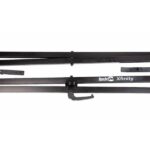Is your flute acting a little stubborn?
One of the most frustrating things that can happen to any flute player is a stuck flute, especially when you’re in the mood to play beautiful melodies.

However, that is not a serious cause for worry because, as always, we will guide you through the process of getting your flute back in top shape.
But before we answer the question of what to do if your flute is stuck, let’s take a quick look at the possible reasons why your flute might be stuck.
Contents
6 Reasons Why Your Flute Is Stuck
Let’s explore some common reasons why your flute might be stuck. Some of these reasons include:
Temperature and Humidity
One common cause of stuck flutes is temperature and humidity.
Flutes are sensitive musical instruments, and extreme temperature changes or humidity swings can cause them to start acting up.
When exposed to increased temperature or humidity, certain parts of the flute might stick together or become misaligned.
The resultant effect is a stuck flute situation. So, it’s important to give your flute a cozy home in a suitable case and protect it from extreme weather conditions.
Moisture
If you own a wooden flute, moisture can be your worst nightmare. Wood is known for its ability to absorb moisture, and this can cause it to swell.
When your wooden flute swells, it makes the keys, joints, or tenons of your flute tight and rigid.
To keep your wooden flute in shape, following the manufacturer’s recommendations regarding oiling or treatment is important to minimize any risk of swelling and, eventually, getting stuck.
Dirt and Debris
Because they are made up of very small particles, dirt is like an uninvited guest at a flute party.
Over time, they can accumulate on your flute’s keys, tenons, or joints.
If you ignore them and forget to clean your flute regularly, these small particles can gradually wreak havoc on the smooth movement of the flute’s mechanisms, making them sticky or even stuck.
Corrosion and Oxidation
Many flutes are made of very special metals like silver or brass. As with every other metal, they are susceptible to corrosion and oxidation.
When moisture comes into contact with metallic flutes, it can lead to the formation of corrosion or tarnish, which can affect the flute’s mechanisms and make them stuck.
Regular cleaning, drying, and proper storage can help prevent corrosion and oxidation.
Misalignment

Misalignment or damage is like a troublemaker that can play pranks on your flute. Of course, we cannot entirely avoid occasional cases of accidental impacts or improper handling.
These can cause misaligned or damaged keywork, rods, or tenons. Additionally, when it has been in use over a lengthy period, you can expect some wear and tear.
If you think your flute might be suffering from this, maybe it is time to visit a skilled technician to realign and fix any damaged part that is causing your flute to stick.
Poorly Fitted Parts
Although very rare, the reason your flute is getting stuck may just be a matter of poor-fitting parts.
For instance, if your flute’s tenons or joints are not tightly fitted or aligned, it can affect the flute’s mechanism.
Human error can cause this problem, especially during assembly, repair, or maintenance. It can also happen if the parts aren’t given the attention they deserve.
When such happens, there are a few things you can do to rectify the issue. Continue reading to find out what you can do.
What to Do If Your Flute is Stuck
Step 1: Take a close look at your flute and inspect it all over to identify where exactly it got stuck. Think of it like you are a detective on a special mission.
Don’t rush, be meticulous, and if need be, turn it this way and that way to determine which part is causing the trouble.
And if you are a professional, you can examine the tenon that connects the pieces or perhaps the joint to find out which of them isn’t budging.
This careful physical inspection will give you valuable insight that could determine your next move.
Step 2: Having identified the faulty part, it is now time to take some steps. You can attempt to nudge your flute back into action.
Gently give the stuck part a slight wiggle or a twist. Remember, you don’t want to make it any worse.
Apply just enough pressure to rekindle movement without forcing anything. Sometimes, all it will take to get things back to normal is a slight nudge.
However, if this nudge does not do the job, you can proceed to the next step.
Step 3: If the gentle nudge or twist does not do the trick, take it a step further by adding some lubricant to the stuck part.
Are you wondering if that is even allowed? Yes, it is! Think of it as giving your flute a soothing massage.
Apply a small amount of recommended lubricant for musical instruments to the stubborn area. As the lubricant works its way into the tiny gaps, it will gradually ease the friction.
Give it some time after doing this and try playing the flute. If the problem persists, move on to the next step.
Step 4: If, after all your efforts, you still haven’t gotten the desired result, it is now time to seek professional help.
If you know professional flute technicians near you, feel free to reach out to them.
Remember, they are experts who have a wealth of experience and a deep understanding of delicate musical instruments like the flute. They will diagnose the problem and fix it.
Flute Maintenance

Dutch philosopher Desiderius Erasmus once said, “Prevention is better than cure.”
To prevent a reoccurrence of this situation where your flute gets stuck, it is important to regularly clean and lubricate your flute according to the manufacturer’s recommendations.
Be sure to store it in a cozy case, like placing it there for a good night’s sleep.
Keep your flute away from weather conditions like temperatures and humidity. Keep it away from every other harsh weather condition.
Verdict
No doubt, you now know what to do if your flute is stuck.
Remember, these steps are not difficult, and they are things you can do on your own, except for the part where you might need to visit an expert.
Hopefully, you won’t need to do that. But no matter what happens, stay calm, be patient, and follow the steps closely.
Soon enough, your flute will be back in action and the melodies will flow again.






